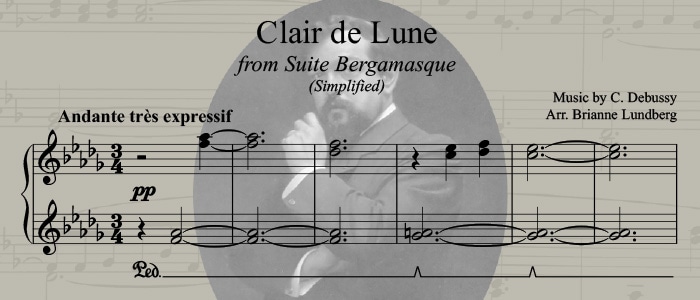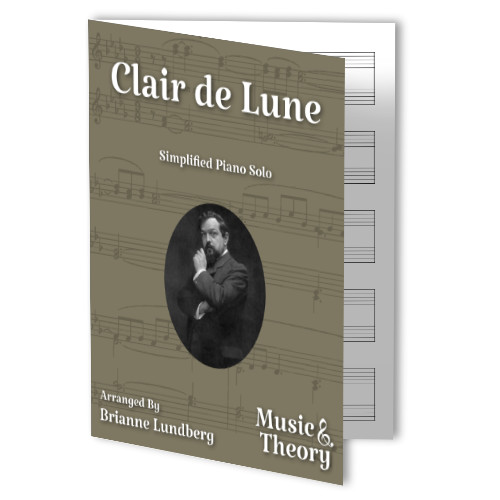Clair de Lune: Simplified Easy Piano Arrangement in Original Key
One of the most rewarding aspects of being both piano teacher an arranger is teaching students to play pieces they love.
However, sometimes a student wants to learn something that is too difficult for them at present. While some teachers might want them to wait until they can learn the original, I believe that a good arrangement can provide them with enjoyment and fulfillment today as well as the motivation to continue to develop their skills so as to one day play the original.
"Clair de Lune" is one of the most recognizable piano pieces. It captures your interest from the first dreamy passage and melts both heart and soul.
Of course, one look at the original Clair de Lune sheet music reveals that it is anything but easy to play. While the introduction seems simple enough, it quickly develops into a blur of notes that only advanced pianists have a hope of playing well.
This simplified arrangement of "Clair de Lune" is perfect for early intermediate piano students. Written in the original key of D-flat major, it keeps the original sparkle but is within reach of a newer pianist's fingers. With this arrangement, pianists can enjoy and perform Debussy now and build essential skills that will help them master Debussy's original works in the future.
How This Simplified Arrangement of Clair de Lune Differs from Others
In an effort to remain true to the spirit of Debussy's original music, this arrangement of Clair de Lune is different from other easy Clair de Lune arrangements I've seen. It differs in the following ways.
Original Key (D-flat Major)
Clair de Lune always sounds best in D-flat Major. Each musical key has a unique feel, and transposing it changes the sound quality. When you search for "easy Clair de Lune sheet music", you will find a plethora of versions in C Major.
But in a musical sense, C Major feels very different from D-flat Major, and it sounds nothing like moonlight (at least, not to my ears!). Clair de Lune piano music in the original key just "shimmers", and no transposed version feels the same. The tempo is slow enough that early intermediate students can learn this arrangement with 5 flats, and to make it easier, I encourage pianists to focus on what's NOT flat (F and C are white keys, everything else is flat).
Includes Two Themes
Often, simplified arrangements only have one well-known theme. Another Clair de Lune easy version might only be for the opening theme. But this version includes the initial well-known main theme as well as part of the secondary moving theme, so that pianists can get a taste of playing the flowing momentum of the secondary theme. This makes the piece feel fuller and grander, perfect for a performance setting.
Original Form Where Possible
The initial well-known main theme of Clair de Lune is really not very difficult to play. (It's the rest of the piece that's the real challenge!) So for this simplified arrangement of Clair de Lune, I kept the simple beauty of the opening theme just as it originally was, with minimal changes.
Teaching Tools in "Clair de Lune" Easy Piano Arrangement
As a piano teacher, I value what each piece of music can teach. As with all my compositions and arrangements, I have listed the educational aspects or "teaching tools" found in this Clair de Lune piano sheet music arrangement.
The most obvious challenge is the flats. The key signature is D-flat Major, with 5 flats. As I said above, I work around this by teaching students to look for what is NOT flat. Once you recognize that everything is flat except for F and C, that F and C are the only white keys and everything else is a black key, suddenly it's much easier. (It feels almost like the reverse of D major -- 5 black keys and 2 white keys instead of 5 white keys and 2 black keys.) Additionally, there are accidentals - several C-flats and F-flats help teach theory and "musical spelling", and why piano music might have an F-flat instead of an E natural. Despite the flats, the tempo is slow, and the feeling of gently caressing the keys makes it all easier to come together.
Arpeggios and broken chords help teach fluency of sound, which notes "go together". Clef changes, 8va, and cross hands (hand-over-hand) teach familiarity with the different octaves of the piano. Various reading challenges are included, like Left Hand treble, Right Hand bass, ties on just one note of a harmonic interval, and ledger lines, but these are not overwhelmingly presented. Lastly, pedaling, dynamics, voices, and rolled chords help early intermediate pianists develop musical expression.
This beginner piano Clair de Lune arrangement has inspired many of my own students to press forward developing their skills. I hope that with this arrangement, many more pianists will dive into learning Clair de Lune for intermediate piano.
Sheet music previews and a full audio preview are available on the "Clair de Lune" product page. Check out more easy classical piano sheet music arrangements and originals for beginner and intermediate students. More arrangements coming soon!




